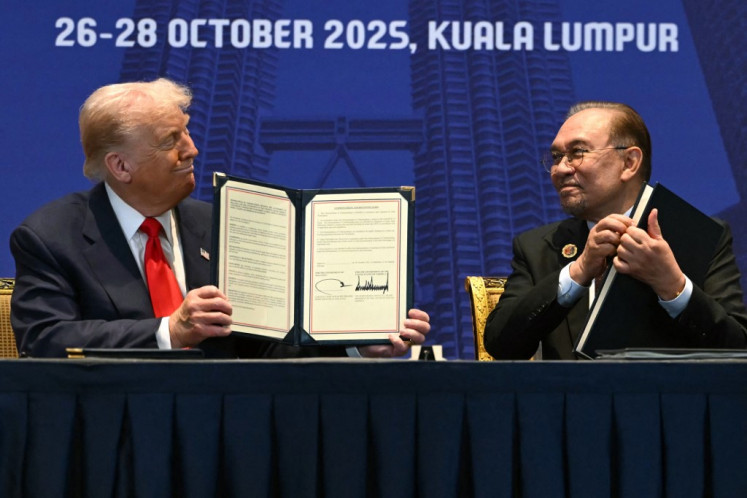Popular Reads
Top Results
Can't find what you're looking for?
View all search resultsPopular Reads
Top Results
Can't find what you're looking for?
View all search resultsThe 5 big problems with Trump’s Gaza peace plan
There are many outstanding questions about the feasibility of the plan and to what extent it is likely to be successful.
Change text size
Gift Premium Articles
to Anyone
T
he 20-point plan recently announced by United States President Donald Trump at a joint news conference with Israeli Prime Minister Benjamin Netanyahu comes close to living up to Trump’s hype. It is a bold attempt to address all the issues that need to be resolved if there is to be lasting peace in Gaza.
Could it work? Both sides are tired of the war. Throughout history, quite a number of wars have simply come to an end when both sides were too exhausted to continue. Two-thirds of Israelis want the war to end, and though polling of Palestinians is difficult, they clearly want the devastation and suffering in Gaza to stop as well.
So this plan, despite its limitations, could come at the right time.
However, there are many outstanding questions about the feasibility of the plan and to what extent it is likely to be successful. Given the Middle East’s violent history, it is impossible to be optimistic at this point.
Here are five main reasons for concern.
First, trust is lacking. There is zero trust between the sides right now. Several aspects of the plan are so vague that there is a big risk both sides could accuse the other of breaking their promises.
The last ceasefire between the two sides lasted only two months before Netanyahu backed out, blaming Hamas for not releasing more hostages before negotiations on the next phase could proceed.
Second, the plan is asymmetrical. The deal favors Israel more than it does Hamas. Hamas is essentially being asked to give up all the remaining Israeli hostages it holds and all of its weapons at the same time, rendering it entirely defenseless.
Hamas, given its lack of trust in Israel and in Netanyahu in particular, may fear the Israeli leader could use this as an opportunity to attack it again without worrying about harming the hostages.
In addition, Hamas was not invited to negotiate the terms of the agreement, and it now faces an ultimatum: accept the terms or Israel will “finish the job.”
Given the asymmetry of the plan, Hamas may decide the risks of accepting it outweigh the potential benefits, despite the plan’s offer of amnesty for Hamas fighters who lay down their arms.
Israel is being asked to make some compromises in the plan. But how realistic are these?
For example, the deal envisions a future when the Palestinian Authority (PA) can “securely and effectively take back control of Gaza.” Netanyahu has previously said he would not accept this.
Likewise, it would be very difficult for Netanyahu to accept “a credible pathway to Palestinian self-determination and statehood,” as outlined in the plan. He has firmly rejected this in the past, most recently in his defiant address to the UN General Assembly last week.
Third, important details are lacking. The implementation strategy of the plan is extraordinarily vague. We know nothing at this stage about the “International Stabilization Force” that would take the place of the Israeli military after it withdraws from Gaza.
Which countries would participate? It would obviously be a mission fraught with danger to the personnel involved. Netanyahu has previously mentioned an Arab force taking over in Gaza, but no Arab states have yet volunteered for this.
There is also no timeframe in the plan for Palestinian Authority reforms, nor any details on what those reforms would entail.
Presumably, there would need to be new elections to install a credible leader in place of current President Mahmoud Abbas. But how that would be done and whether the people of Gaza would be able to take part is still unknown.
In addition, the details of the civil authority that would oversee the reconstruction of Gaza are very unclear. All we know is that Trump would appoint himself chair of the “Board of Peace,” and former British Prime Minister Tony Blair would also be involved.
This board would need the absolute confidence of the Netanyahu government and of Hamas to be effective. Trust is always in short supply in the Middle East.
Fourth, no mention of the West Bank. The West Bank is clearly a flashpoint. There are disputes and clashes every day between Israeli settlers and Palestinian residents, which are only likely to get worse.
Just last month, the Israeli government gave final approval to a controversial plan to build a new settlement that would effectively divide the West Bank in two, making a future contiguous Palestinian state unviable.
The West Bank must be central to any overall settlement between Israel and Palestine.
Fifth, Israel’s right-wing cabinet remains an obstacle. This could be the ultimate dealbreaker: the hardline, right-wing members of Netanyahu’s cabinet, Bezalel Smotrich and Itamar Ben-Gvir, have said they will not accept anything less than the complete destruction and elimination of Hamas.
Although Hamas would be disarmed and politically sidelined under this plan, its ideology would remain intact, as would a significant number of its fighters.
So does it have a chance? If Hamas accepts Trump’s plan, we could soon have the answers to several of these questions.
But it is going to require a great deal of work by the US to maintain pressure on Israel to stick to the deal. The chief Palestinian mediators, Qatar and Egypt, would also need to maintain pressure on Hamas so it does not breach the conditions as well.
Netanyahu is likely assuming there will be sufficient off-ramps for him to get out of the agreement if Hamas does not live up to it. Netanyahu has already done this once when he backed out of the ceasefire in March and resumed Israel’s military operations.
In his forceful speech to a partially empty United Nations General Assembly hall last week, Netanyahu did not indicate he was thinking of walking away from any of the red lines he had previously set to end the war. In fact, he condemned the states recognizing a Palestinian state and vowed, “Israel will not allow you to shove a terror state down our throats.”
Given this, Netanyahu would not have agreed to Trump’s plan at all if the US leader had not put pressure on him. At the same time, Trump said at his news conference with Netanyahu that if Hamas fails to live up to the agreement or refuses to accept it, Israel would have his full backing to finish the job against Hamas.
This promise may be enough for Netanyahu to be able to persuade Smotrich and Ben-Gvir to support the plan, for now.
---
The writer is a research scholar in Middle East Studies at Australian National University. The article is republished under a Creative Commons license.
Your Opinion Matters
Share your experiences, suggestions, and any issues you've encountered on The Jakarta Post. We're here to listen.
Thank you
Thank you for sharing your thoughts. We appreciate your feedback.











